The history of Soviet cassette players: the evolution of the Gums, the MK-60 made in USA and the 70's folk tape recorders
Continuing our cycle about Soviet audio, I wanted to talk about tape recorders in the USSR. It is known that in the Land of the Soviets these devices began to appear somewhat later than in the west, and disappeared to the contrary earlier (their production was curtailed almost immediately after the collapse of the Union).

I was interested to analyze how close our developers were to their colleagues from Japan, Western Europe and the USA, whether they managed to catch up and overtake them, and also to understand why Soviet developments in this area sometimes used rare or so-called “forced” demand, and most their contemporaries sought to acquire foreign samples.
')
Due to the fact that the topic is quite extensive, I will divide the material into four parts, in the first two I will talk about the evolution of portable devices, and in the rest - I will consider the development and decline of stationary decks.
The history of Soviet tape cassette recorders under the standard compact cassette began 5-6 years later than in the west, which generally coincides with the chronological lag of the country of the victorious developed socialism from the “western partners” in consumer electronics. It is known that the first cassette tape recorders (with magnetic wire) appeared as early as the Third Reich in the 1930s, such as those produced in particular by C. Lorenz AG. The first tape recorder with magnetic tape was released in 1950, it was Loewe Optaphon.

30's cassette recorder
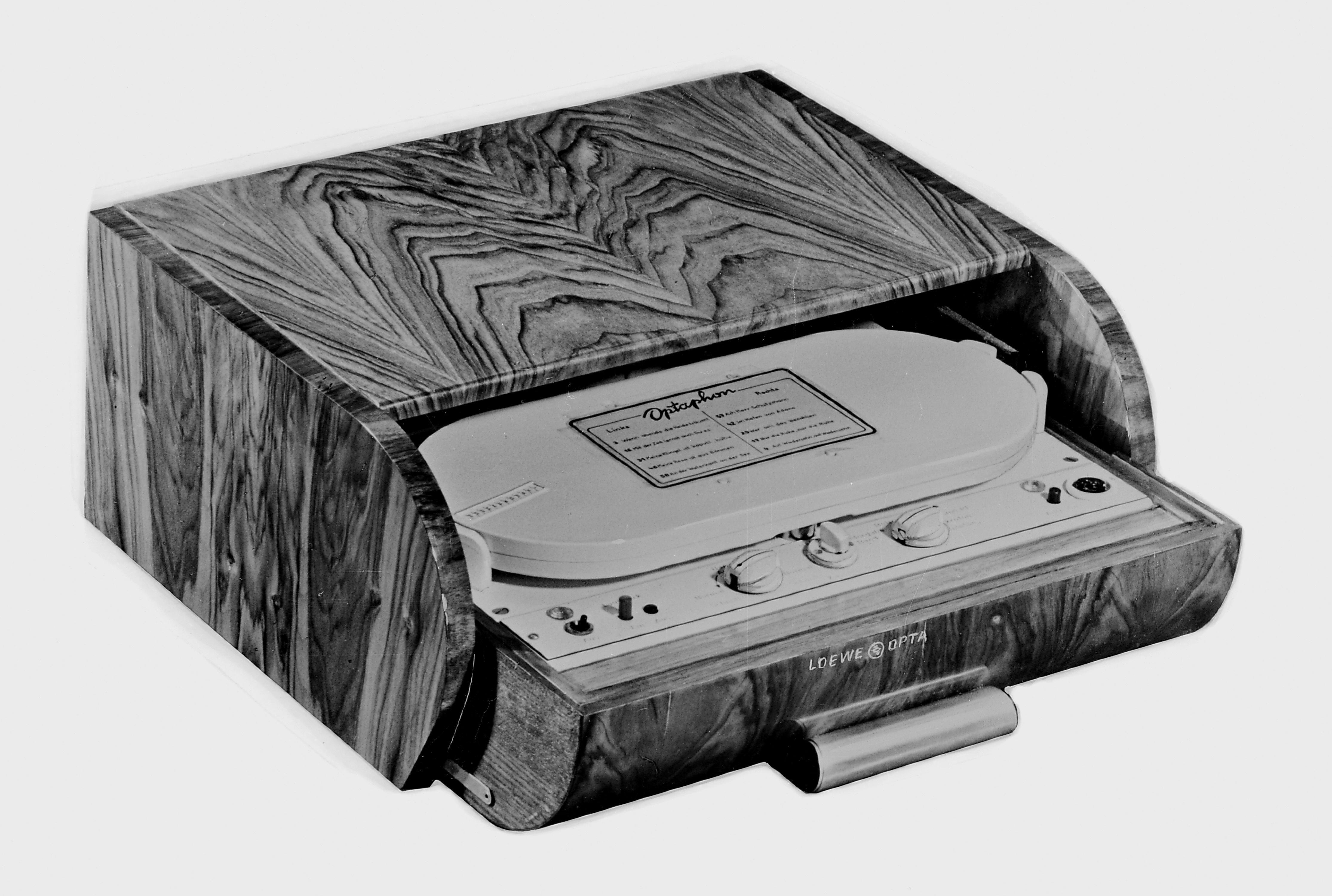
Loewe optaphon
All this time the cassettes did not attach importance in the USSR and treated with coils, which received the popular name of the reel. In 1963, Philips introduced a compact cassette, and in 1964 one of the first portable devices for playing it appeared, the Philips EL3300. In the future, this particular portable tape recorder served as a prototype for the Soviet firstborn, “Desna”.

EL3300

"Gum"
It should be noted that in the 1960s tape recorders were in great shortage in the Land of the Soviets, and until the advent of Gums, there were only reel-to-reels. Understanding the lag in this area, Soviet officials set the task for engineers to copy the Philips EL3300. The development (ie, copying mechanics and electronics adaptation) was entrusted to the Kharkov radio factory Proton, which by 1969 was able to master the serial production of the novelty.

The layout, the design of the tape drive mechanism, and the case design were identical to the EL3300. Electronics had a number of significant differences and sometimes even surpassed the Dutch design. So the power of the Soviet device had five stages (Philips had four), a separate transistor speed regulator was provided for the engine. The element base was also different, since the overseas device used seven, and Desna used nine germanium transistors. The significant difference was the supply voltage (9 V for “Gums, 7.5 from EL3300), for which in“ Desna ”it was necessary to increase the number of batteries. This led to an increase in size - the length increased by 26 mm.
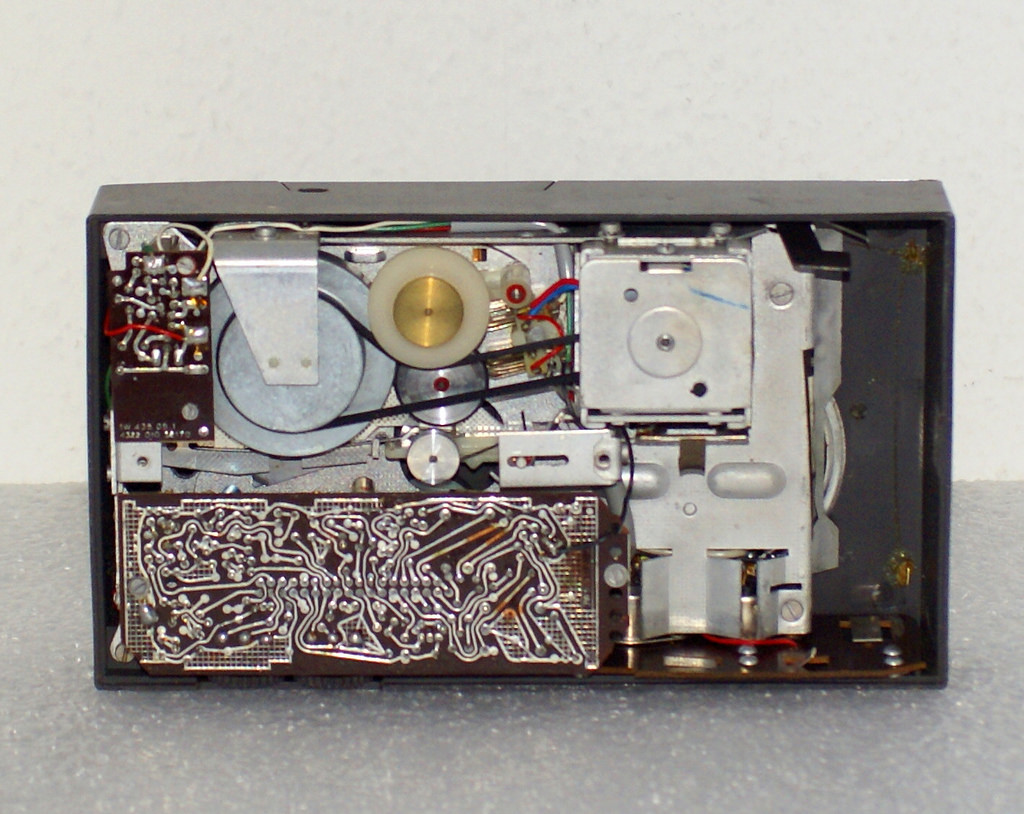
EL3300 inside
Characteristic advantages, except for a relatively small size, compared with reel counterparts, the tape recorder did not have, and there was at least one glaring drawback - the price. The gadget cost 220 rubles - about 2 times the salary of an experienced engineer. Given the low 4th grade of the device, we can assume that the novelty was noncompetitive even in the Soviet market, starved by technology.
A separate problem was to get the tapes, which at that time were produced in very small editions and were rare. Interestingly, the Proton MK-60 compact cassettes (with a duration of 38, 40 or 60 minutes) were created before the Desna appeared.
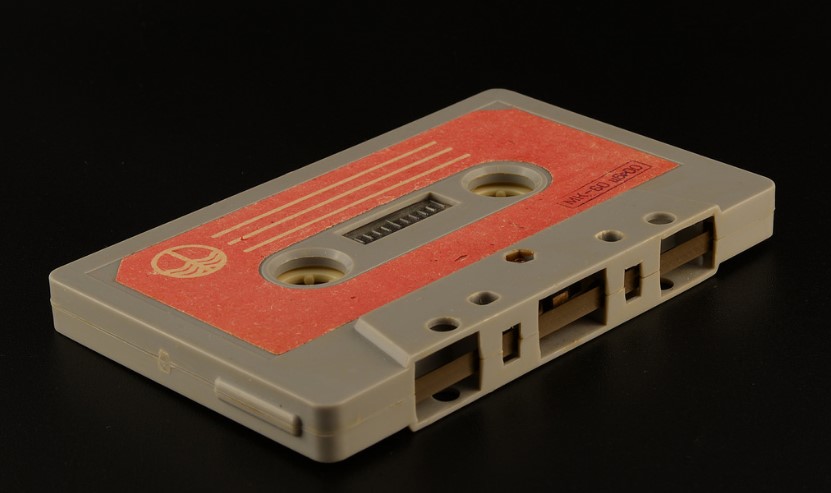
The tape recorder itself was planned to be released for the 50th anniversary of the Great October Socialist Revolution, i.e. in 1967, but did not have time, and the first print run of the Proton was already born. Copying the media turned out to be easier than adapting a foreign tape recorder for the series.
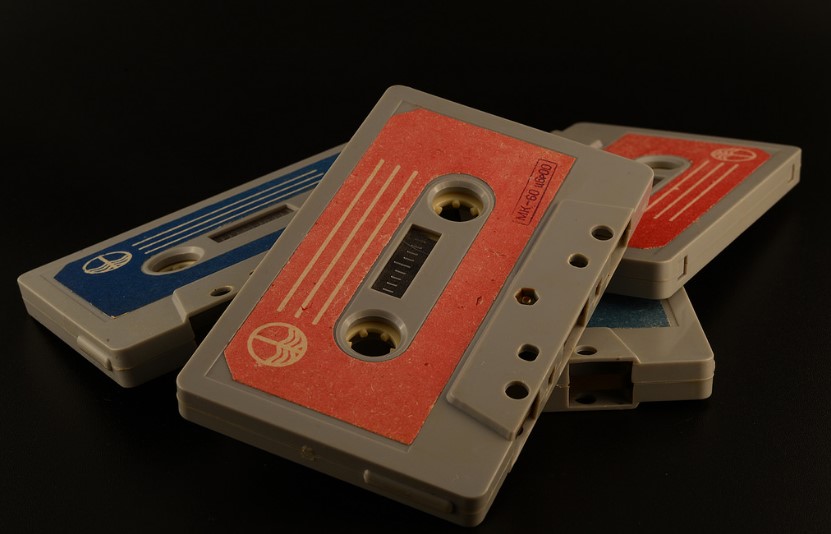
The appearance of the Soviet cassettes was extremely ascetic, if not to say miserable, they did not bother with the design, and the words of such in the Country of the Soviets in those years did not know, they limited themselves to a simple sticker.
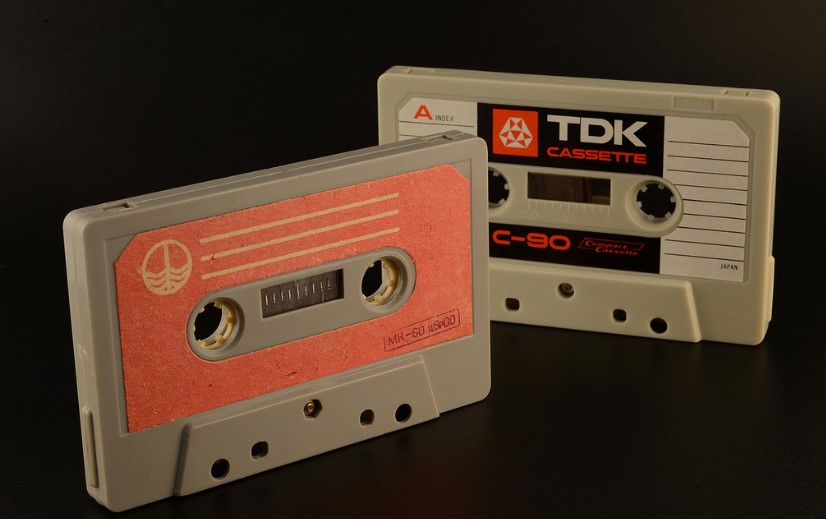
Moreover, until the beginning of the 70s the cassettes were not completely Soviet, the tape for them was released in the GDR at the enterprise “Filmfabrik Wolfen”. Since 1971, the production of films for cassettes has been organized at several enterprises of the USSR, in particular, at the Swema plant. Later, there began the production of cassettes.
The price tag, as in the case of the first cassette tape recorder, was almost cosmic for a Soviet person at the end of the 60s - 6 rubles for one cassette. This, like the lack of media, also did not contribute to the popularity of the device.
The legend lives up to this day (https://daxgarth.wordpress.com/2017/08/23/compact-cassette-proton-ussr/) that in the first “Proton MK-60” it was possible to detect various types of undecorated inscriptions “Made in USA”, and also that they finally disappeared in the early 70s. I could not find confirmation of this, but I fully admit that this could be.
I would be happy to comment, share your thoughts about how the inscription could be on the tape (I have several hypotheses).
Despite the comparative failure of the first cassette, Kharkov engineers highly appreciated the modernization potential of their offspring. Looking ahead, I will say that the Soviet “Philips” was modernized right up to 1982. Having carried out a thorough work on the bugs, by 1971 they produced Sputnik and Sputnik-401. A year later, the production of the modernized version was mastered by the instrument-making plant in Arzamas. The next modified clone of “Desna” received the sonorous name “Legend-401”.

New tape recorders received better sound. The detonation was reduced, the signal-to-noise ratio was improved, the indicators of the amplifiers were thoroughly improved, the optimization of circuit solutions for Sputnik-401 was carried out, even provided for the use of the second speed - 2.38 cm / s.
Another characteristic difference was the possibility of using so-called. radio cassettes, inserting which could turn the tape recorder into a DV-radio receiver. They became a kind of MP3 cassettes that were seriously hapanulized a couple of years ago.

Radio cassette inside

Radio cassette
At the same time, the cost of the devices became lower and amounted to 180 rubles, which, simultaneously with the improvements and the growth of cluster circulations, qualitatively influenced the demand.
In 1974 and 76, two more Kharkov modernization followed, they became the most popular versions of Desna of that period - Sputnik-402 and Sputnik-403. Models received cosmetic and optimization updates, improved circuitry. The tape equipment copied from the Filipsov firstborn remained unchanged.
We can safely say that Sputnik 404, which was released in 1982, became the last device in the Gums family. From the Dutch progenitor from the 60s, the tape recorder traditionally borrowed tape drive mechanics and layout.

One of the most significant and most popular in the 70s - 80s rulers of portable tape recorders became devices with the name “Spring”. They were also created in the Ukrainian SSR, which at that time, along with the majority of the western republics, performed the function of an all-Union assembly workshop. Tape recorders under the Vesna brand were produced at the Iskra enterprise in Zaporozhye, as well as at the Kommunist plant in Kiev (now Radar).

Spring-305
The first cassette tape recorder of the original design (probably the first Soviet portable tape recorder of “own” development) was planned to be released in 1971. They were supposed to be a device with a two-speed brushless BDS engine with electronic control, which up to this point had not been produced in the USSR.
The engine became a headache for developers, and the Soviet users, tired of the problematic "gums", clearly needed something new. Then the developers abandoned the complex engine, replacing it with a classic Japanese collector motor.
So the first folk cassette - "Spring-305" was born. A year later, the people of Kiev finalized a three-phase brushless motor (called the BDS-0.2) and the release of Spring-306 started in Zaporozhye. Functional difference between the devices was the presence of a flagship with a brushless motor of two speeds of work (4.76 and 2.38 cm / s, respectively).
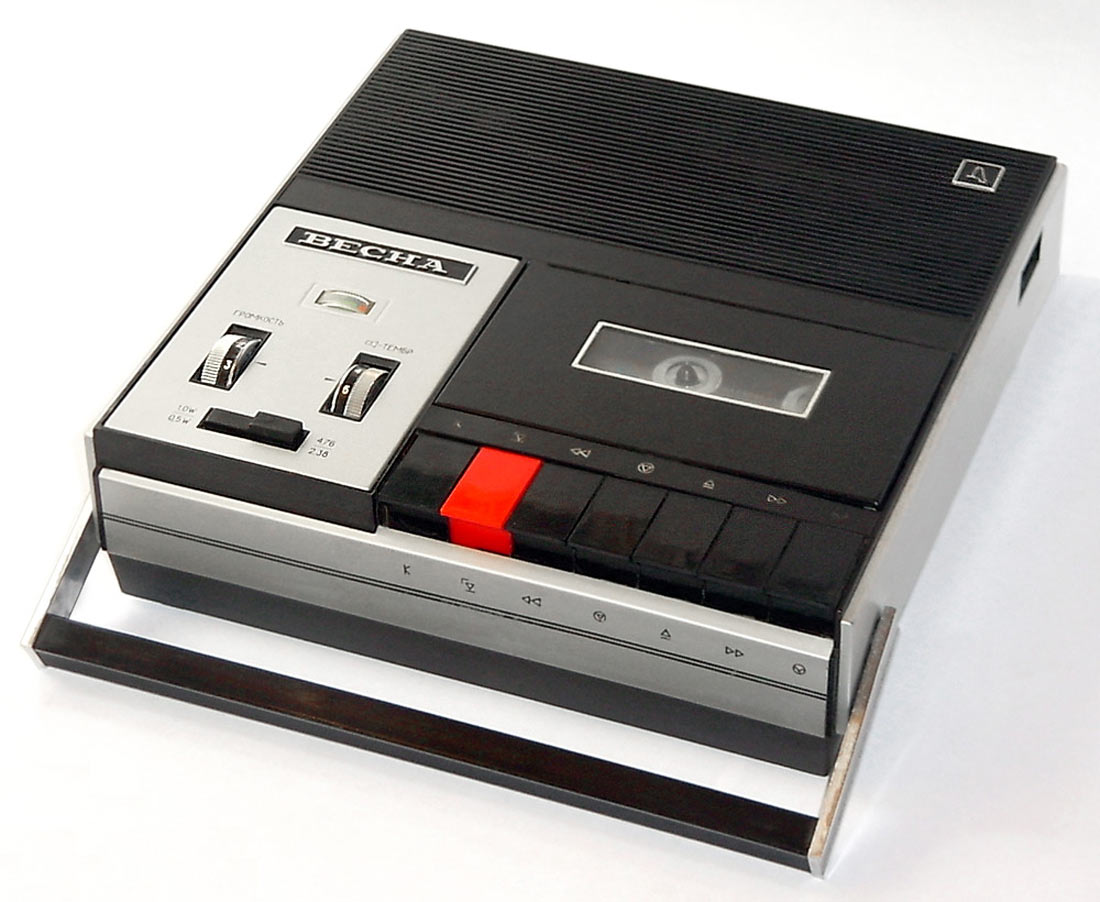
Spring-306
Thanks to the new engine, the Spring-306 had a long battery life, low power consumption, and also created less interference with work. At the same time, the stability of the device revolutions was higher, and accordingly, higher fidelity of reproduction was ensured.
Despite the obvious advantages of the model 306, users have recognized the “Spring -305” as a true folk tape recorder. The fact is that the ravines, as usual, have been forgotten. Lack of experience in the production of brushless AC motors and poor build quality more than offset the advantages of the engine. The failing complex engine with electronic synchronization is often replaced by a Japanese engine from the “Spring-305”, a little reducing the quality, but equalizing the tape recorders in operational reliability.

In other words, the tape recorders of this line were not loved by the new engine. The most valuable operational merit of the system was the tape drive mechanism, which, contrary to custom, was not copied from Western samples, but was created from scratch. It was equipped with two identical flywheels, which rotated in different directions and, thanks to the double weight, significantly increased the stability of the ribbon pulling. This was especially helpful during handling. Since 1976, the full analogues “Spring 305” and “Spring-306” were made by the Perm electrical appliance plant, they were called “Rhythm-301”.

The stability and reliability of the mechanism made it a universal platform, on the basis of which other Soviet tape recorders "Romantic-306", "Electronics-311", "Electronics-323", "Kvazar-303" were created. I think it would not be a mistake to attribute these devices to the “Spring - 305 - 306” family.
The characteristics of the early “Spring” tape recorders, which in many respects exceeded the norms of the declared third class, deserve special attention:
Almost without change, the models 305 and 306 were produced until 1978, in total these tape recorders produced more than 850 thousand. If you believe the article in Wikipedia, today it is difficult to find workable copies, as a reliable design made it possible to mercilessly expend an operational resource. On the basis of models 305 and 306, functionally improved models Spring-202 and Spring-205, as well as (to some extent) Spring-204 radio tape recorder, were further developed.
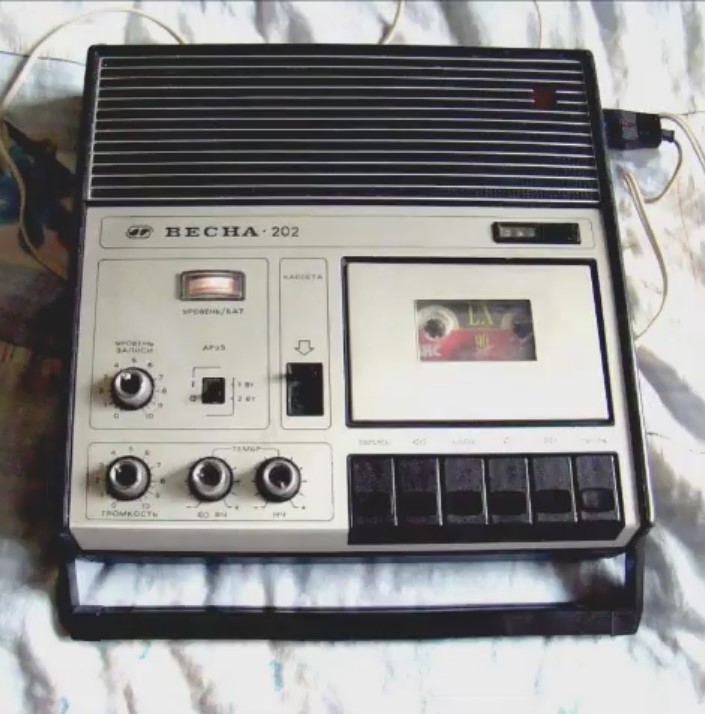
In the future, Kiev “Communist” and Zaporozhye “Spark” released portable stereo tape recorders. "Spring-201 stereo" appeared in 1977, in 1978 - an improved version of "Spring-211 stereo", which was equipped with a more powerful amplifier and an additional stereo pair.
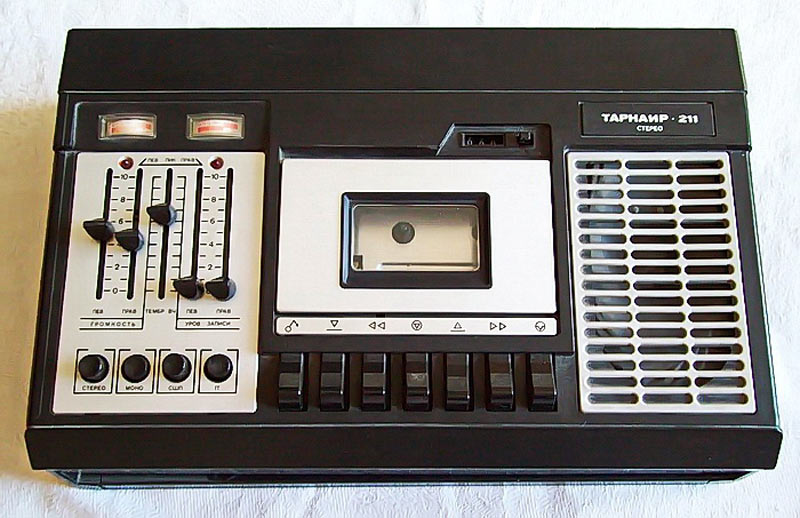
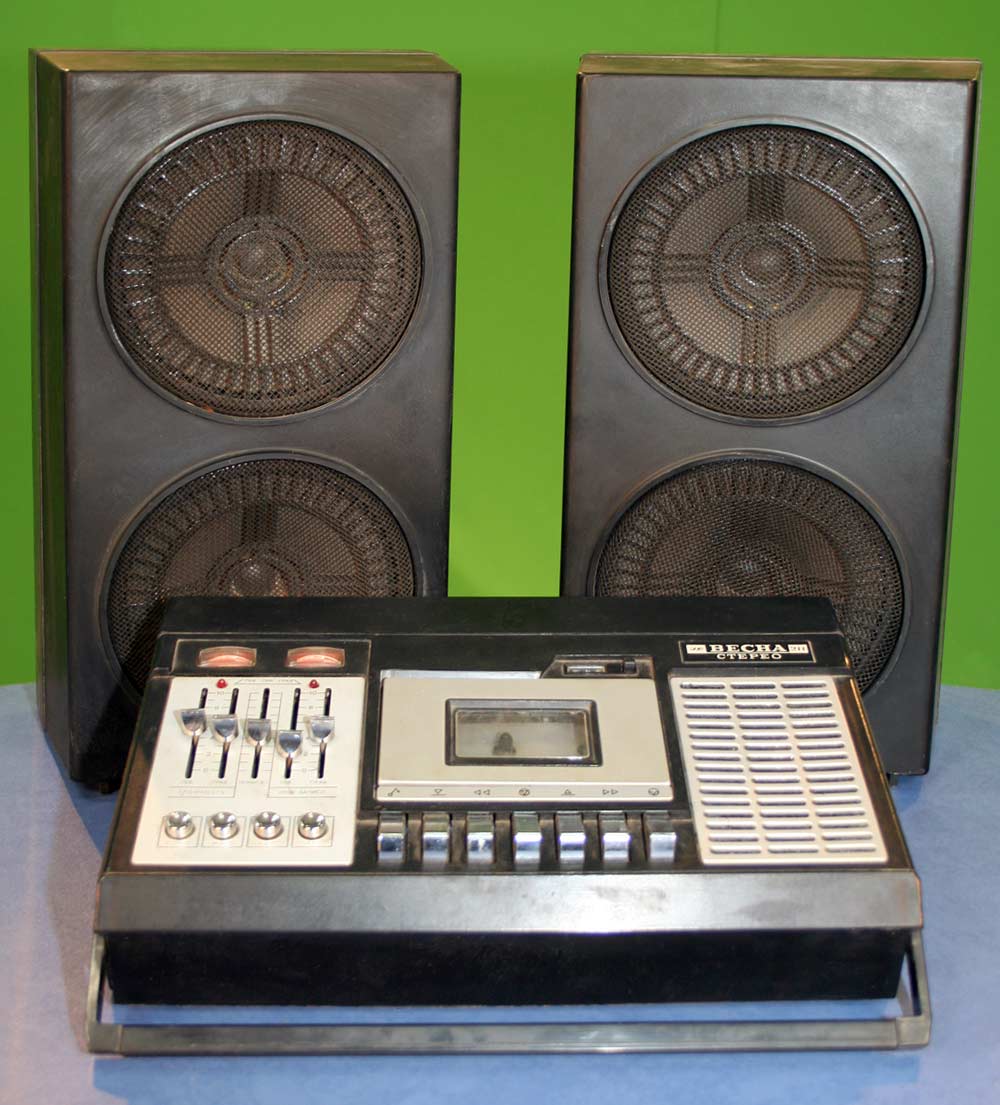
For the Soviet recordings of the mid-to-late 1970s, this was not only a breakthrough, but a success and an indicator of serious progress. The next stage for “Spring” came in 1985, when the production of the “Spring-310C” line began - tape recorders with a fundamentally new layout scheme.

Subsequently, identical devices were successfully copied by the Ryazan instrument factory and were also issued under the “Rus” brand.

The story about the folk tape recorder will be incomplete without mentioning “Electronics 301” (aka Parus-301, developed by the Moscow TochMash plant.

This tape recorder, as well as the “Spring-305/306”, gained immense popularity among Soviet citizens due to its high reliability combined with tolerable characteristics. Its serial production was launched in 1972. Traditionally, the model was partially copied from a C100L tape recorder, produced by Grundig from 1966 to 1968.
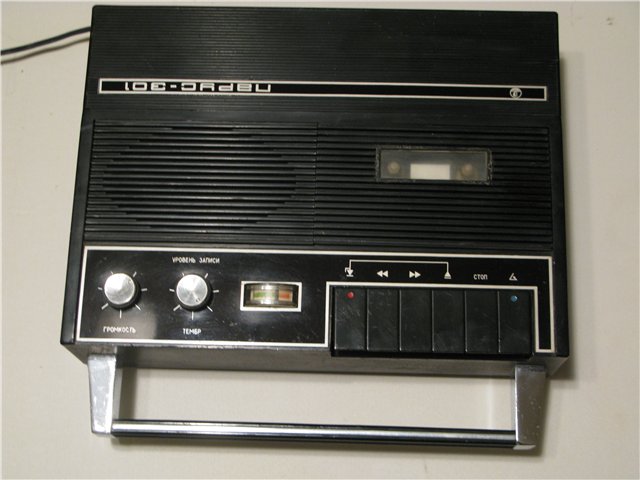
"Sail 301"

Grundig C100L
The tape recorder received a wear-resistant tape drive mechanism, electronic speed stabilization, and also a relatively good amplifier with germanium transistors. After 2 years, it was upgraded to the version of “Electronics 302“, with the design as close as possible to the original and using the 1GD-40 loudspeaker instead of 0.5GD-30, which improved the fidelity of playback.
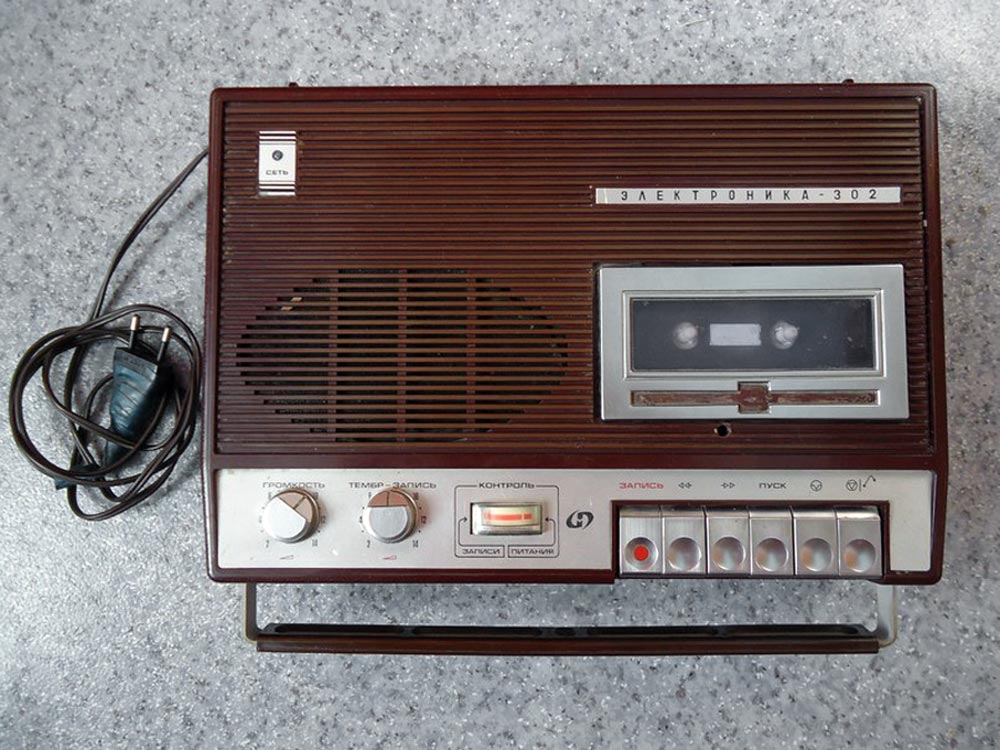
At various times, various components were used in the tape recorder, several versions were obtained by Japanese JVC heads and SONY engines.
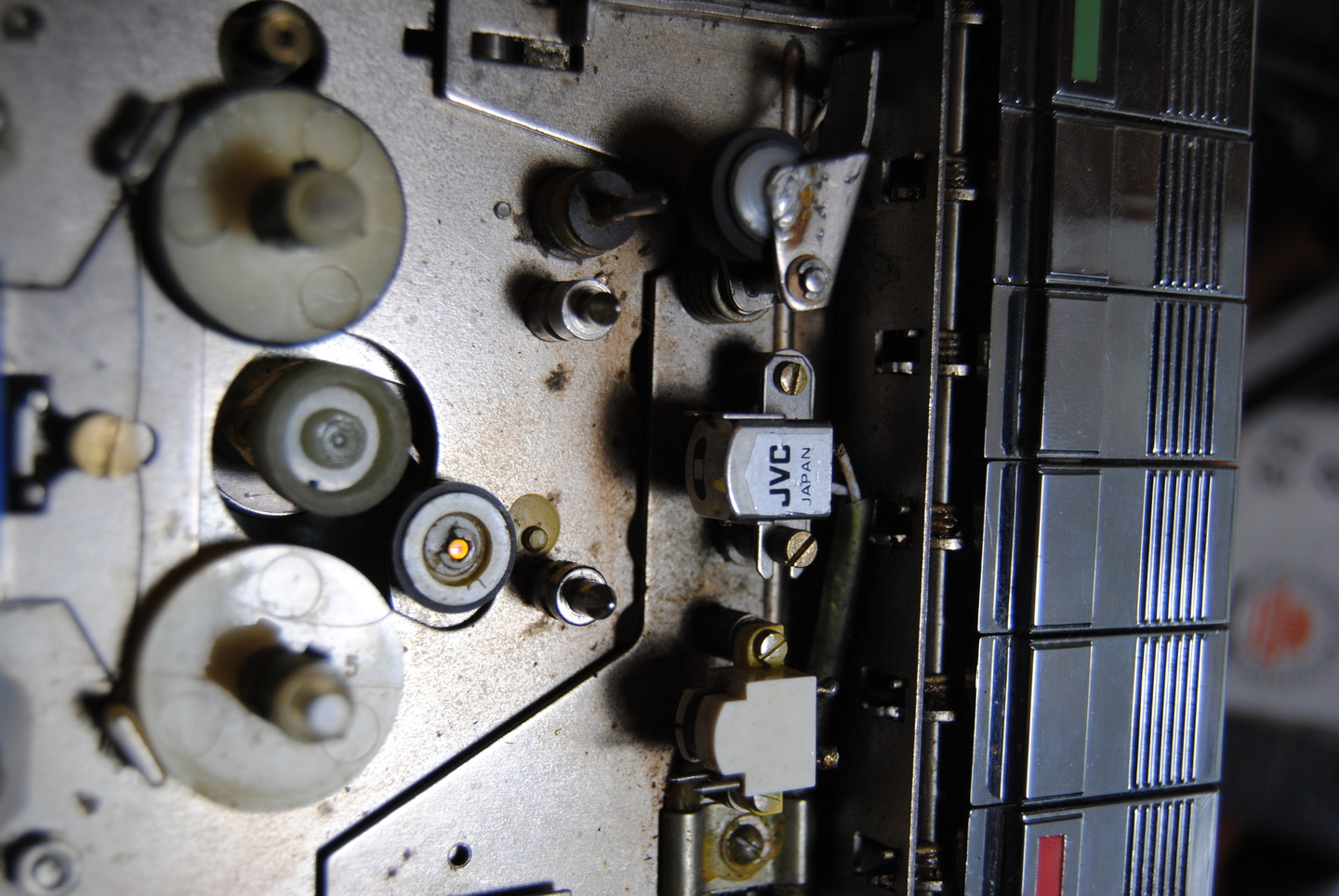
The dawn of the Soviet tape making can be called a period of frantic search,unscrupulous plagiarism of bold borrowing and skillful adaptations of Western developments. Cassette tape recorders it concerns, perhaps even more than the reel. It should be noted that their own development was sometimes more suitable for users, because they adapted to their requirements, and were, as people say, unkillable. I think I’m not mistaken if I say that Soviet engineers gave new life to devices that were considered obsolete in the West and were able to effectively use their modernization potential. I would traditionally appreciate your comments. This is not all, to be continued .
Photo content used:
www.rw6ase.narod.ru
www.flickr.com/photos/41902337@N07
daxgarth.wordpress.com/2017/08/23/compact-cassette-proton-ussr
stereo.ru
forums.balancer.ru/tech/forum/2012/07/t66563_2--muzej-elektronnykh-raritetov.html
www.radiomuseum.org/r/grundig_c100l.html
igrovoetv.online
(If you are against using your photos in our material - write to us and we will replace them)
Jeans
We trade in electronics. A wide range of audio and video equipment, accessories, switching is presented in our catalog .

I was interested to analyze how close our developers were to their colleagues from Japan, Western Europe and the USA, whether they managed to catch up and overtake them, and also to understand why Soviet developments in this area sometimes used rare or so-called “forced” demand, and most their contemporaries sought to acquire foreign samples.
')
Due to the fact that the topic is quite extensive, I will divide the material into four parts, in the first two I will talk about the evolution of portable devices, and in the rest - I will consider the development and decline of stationary decks.
Spirit of 1969 or 26 mm original design
The history of Soviet tape cassette recorders under the standard compact cassette began 5-6 years later than in the west, which generally coincides with the chronological lag of the country of the victorious developed socialism from the “western partners” in consumer electronics. It is known that the first cassette tape recorders (with magnetic wire) appeared as early as the Third Reich in the 1930s, such as those produced in particular by C. Lorenz AG. The first tape recorder with magnetic tape was released in 1950, it was Loewe Optaphon.

30's cassette recorder

Loewe optaphon
All this time the cassettes did not attach importance in the USSR and treated with coils, which received the popular name of the reel. In 1963, Philips introduced a compact cassette, and in 1964 one of the first portable devices for playing it appeared, the Philips EL3300. In the future, this particular portable tape recorder served as a prototype for the Soviet firstborn, “Desna”.

EL3300

"Gum"
It should be noted that in the 1960s tape recorders were in great shortage in the Land of the Soviets, and until the advent of Gums, there were only reel-to-reels. Understanding the lag in this area, Soviet officials set the task for engineers to copy the Philips EL3300. The development (ie, copying mechanics and electronics adaptation) was entrusted to the Kharkov radio factory Proton, which by 1969 was able to master the serial production of the novelty.

The layout, the design of the tape drive mechanism, and the case design were identical to the EL3300. Electronics had a number of significant differences and sometimes even surpassed the Dutch design. So the power of the Soviet device had five stages (Philips had four), a separate transistor speed regulator was provided for the engine. The element base was also different, since the overseas device used seven, and Desna used nine germanium transistors. The significant difference was the supply voltage (9 V for “Gums, 7.5 from EL3300), for which in“ Desna ”it was necessary to increase the number of batteries. This led to an increase in size - the length increased by 26 mm.

EL3300 inside
Characteristic advantages, except for a relatively small size, compared with reel counterparts, the tape recorder did not have, and there was at least one glaring drawback - the price. The gadget cost 220 rubles - about 2 times the salary of an experienced engineer. Given the low 4th grade of the device, we can assume that the novelty was noncompetitive even in the Soviet market, starved by technology.
Hasty "Protons"
A separate problem was to get the tapes, which at that time were produced in very small editions and were rare. Interestingly, the Proton MK-60 compact cassettes (with a duration of 38, 40 or 60 minutes) were created before the Desna appeared.

The tape recorder itself was planned to be released for the 50th anniversary of the Great October Socialist Revolution, i.e. in 1967, but did not have time, and the first print run of the Proton was already born. Copying the media turned out to be easier than adapting a foreign tape recorder for the series.

The appearance of the Soviet cassettes was extremely ascetic, if not to say miserable, they did not bother with the design, and the words of such in the Country of the Soviets in those years did not know, they limited themselves to a simple sticker.

Moreover, until the beginning of the 70s the cassettes were not completely Soviet, the tape for them was released in the GDR at the enterprise “Filmfabrik Wolfen”. Since 1971, the production of films for cassettes has been organized at several enterprises of the USSR, in particular, at the Swema plant. Later, there began the production of cassettes.
The price tag, as in the case of the first cassette tape recorder, was almost cosmic for a Soviet person at the end of the 60s - 6 rubles for one cassette. This, like the lack of media, also did not contribute to the popularity of the device.
The legend lives up to this day (https://daxgarth.wordpress.com/2017/08/23/compact-cassette-proton-ussr/) that in the first “Proton MK-60” it was possible to detect various types of undecorated inscriptions “Made in USA”, and also that they finally disappeared in the early 70s. I could not find confirmation of this, but I fully admit that this could be.
I would be happy to comment, share your thoughts about how the inscription could be on the tape (I have several hypotheses).
Descendants of the Gums
Despite the comparative failure of the first cassette, Kharkov engineers highly appreciated the modernization potential of their offspring. Looking ahead, I will say that the Soviet “Philips” was modernized right up to 1982. Having carried out a thorough work on the bugs, by 1971 they produced Sputnik and Sputnik-401. A year later, the production of the modernized version was mastered by the instrument-making plant in Arzamas. The next modified clone of “Desna” received the sonorous name “Legend-401”.

New tape recorders received better sound. The detonation was reduced, the signal-to-noise ratio was improved, the indicators of the amplifiers were thoroughly improved, the optimization of circuit solutions for Sputnik-401 was carried out, even provided for the use of the second speed - 2.38 cm / s.
Another characteristic difference was the possibility of using so-called. radio cassettes, inserting which could turn the tape recorder into a DV-radio receiver. They became a kind of MP3 cassettes that were seriously hapanulized a couple of years ago.

Radio cassette inside

Radio cassette
At the same time, the cost of the devices became lower and amounted to 180 rubles, which, simultaneously with the improvements and the growth of cluster circulations, qualitatively influenced the demand.
In 1974 and 76, two more Kharkov modernization followed, they became the most popular versions of Desna of that period - Sputnik-402 and Sputnik-403. Models received cosmetic and optimization updates, improved circuitry. The tape equipment copied from the Filipsov firstborn remained unchanged.
We can safely say that Sputnik 404, which was released in 1982, became the last device in the Gums family. From the Dutch progenitor from the 60s, the tape recorder traditionally borrowed tape drive mechanics and layout.

Zaporozhye "Spring"
One of the most significant and most popular in the 70s - 80s rulers of portable tape recorders became devices with the name “Spring”. They were also created in the Ukrainian SSR, which at that time, along with the majority of the western republics, performed the function of an all-Union assembly workshop. Tape recorders under the Vesna brand were produced at the Iskra enterprise in Zaporozhye, as well as at the Kommunist plant in Kiev (now Radar).

Spring-305
The first cassette tape recorder of the original design (probably the first Soviet portable tape recorder of “own” development) was planned to be released in 1971. They were supposed to be a device with a two-speed brushless BDS engine with electronic control, which up to this point had not been produced in the USSR.
The engine became a headache for developers, and the Soviet users, tired of the problematic "gums", clearly needed something new. Then the developers abandoned the complex engine, replacing it with a classic Japanese collector motor.
So the first folk cassette - "Spring-305" was born. A year later, the people of Kiev finalized a three-phase brushless motor (called the BDS-0.2) and the release of Spring-306 started in Zaporozhye. Functional difference between the devices was the presence of a flagship with a brushless motor of two speeds of work (4.76 and 2.38 cm / s, respectively).

Spring-306
Thanks to the new engine, the Spring-306 had a long battery life, low power consumption, and also created less interference with work. At the same time, the stability of the device revolutions was higher, and accordingly, higher fidelity of reproduction was ensured.
Despite the obvious advantages of the model 306, users have recognized the “Spring -305” as a true folk tape recorder. The fact is that the ravines, as usual, have been forgotten. Lack of experience in the production of brushless AC motors and poor build quality more than offset the advantages of the engine. The failing complex engine with electronic synchronization is often replaced by a Japanese engine from the “Spring-305”, a little reducing the quality, but equalizing the tape recorders in operational reliability.

In other words, the tape recorders of this line were not loved by the new engine. The most valuable operational merit of the system was the tape drive mechanism, which, contrary to custom, was not copied from Western samples, but was created from scratch. It was equipped with two identical flywheels, which rotated in different directions and, thanks to the double weight, significantly increased the stability of the ribbon pulling. This was especially helpful during handling. Since 1976, the full analogues “Spring 305” and “Spring-306” were made by the Perm electrical appliance plant, they were called “Rhythm-301”.

The stability and reliability of the mechanism made it a universal platform, on the basis of which other Soviet tape recorders "Romantic-306", "Electronics-311", "Electronics-323", "Kvazar-303" were created. I think it would not be a mistake to attribute these devices to the “Spring - 305 - 306” family.
The characteristics of the early “Spring” tape recorders, which in many respects exceeded the norms of the declared third class, deserve special attention:
- The working range of sound frequencies on the linear output at a speed of 4.76 cm / s - 63 ... 10 000 Hz, at a speed of 2.38 cm / s - 63 ... 5000 Hz.
- Rated output power: 0.8 watts.
- Power supply - 9 volts (six elements 373 or AC network, built-in power supply),
- The tape recorder maintains performance when the voltage drops to 5.1 V.
- Dimensions tape - 242 × 242 × 68 mm.
- Weight with batteries 3.7 kg.
- The price at the start of sales reached 195 rubles, by 1978, it fell and 165 rubles.
Continuation of “Spring”
Almost without change, the models 305 and 306 were produced until 1978, in total these tape recorders produced more than 850 thousand. If you believe the article in Wikipedia, today it is difficult to find workable copies, as a reliable design made it possible to mercilessly expend an operational resource. On the basis of models 305 and 306, functionally improved models Spring-202 and Spring-205, as well as (to some extent) Spring-204 radio tape recorder, were further developed.

In the future, Kiev “Communist” and Zaporozhye “Spark” released portable stereo tape recorders. "Spring-201 stereo" appeared in 1977, in 1978 - an improved version of "Spring-211 stereo", which was equipped with a more powerful amplifier and an additional stereo pair.


For the Soviet recordings of the mid-to-late 1970s, this was not only a breakthrough, but a success and an indicator of serious progress. The next stage for “Spring” came in 1985, when the production of the “Spring-310C” line began - tape recorders with a fundamentally new layout scheme.

Subsequently, identical devices were successfully copied by the Ryazan instrument factory and were also issued under the “Rus” brand.

People’s Soviet Grundig or simply “Electronics 301”
The story about the folk tape recorder will be incomplete without mentioning “Electronics 301” (aka Parus-301, developed by the Moscow TochMash plant.

This tape recorder, as well as the “Spring-305/306”, gained immense popularity among Soviet citizens due to its high reliability combined with tolerable characteristics. Its serial production was launched in 1972. Traditionally, the model was partially copied from a C100L tape recorder, produced by Grundig from 1966 to 1968.

"Sail 301"

Grundig C100L
The tape recorder received a wear-resistant tape drive mechanism, electronic speed stabilization, and also a relatively good amplifier with germanium transistors. After 2 years, it was upgraded to the version of “Electronics 302“, with the design as close as possible to the original and using the 1GD-40 loudspeaker instead of 0.5GD-30, which improved the fidelity of playback.

At various times, various components were used in the tape recorder, several versions were obtained by Japanese JVC heads and SONY engines.

Total
The dawn of the Soviet tape making can be called a period of frantic search,
Photo content used:
www.rw6ase.narod.ru
www.flickr.com/photos/41902337@N07
daxgarth.wordpress.com/2017/08/23/compact-cassette-proton-ussr
stereo.ru
forums.balancer.ru/tech/forum/2012/07/t66563_2--muzej-elektronnykh-raritetov.html
www.radiomuseum.org/r/grundig_c100l.html
igrovoetv.online
(If you are against using your photos in our material - write to us and we will replace them)
Jeans
We trade in electronics. A wide range of audio and video equipment, accessories, switching is presented in our catalog .
Source: https://habr.com/ru/post/442358/
All Articles